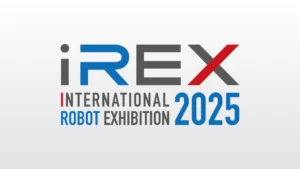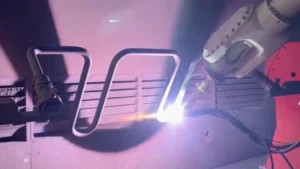table of contents
- Heading 1
- Heading 1
- Heading 1
share this
Why the Production Line Needs a Second Look
Manufacturers today are caught between two seismic shifts. Rising labor cost[1][2] and labor shortages[3] continue to deepen, with an estimated 10 million vacancies in global manufacturing[4]. Simultaneously, market demand is pushing manufacturers toward greater product diversity and mass customization—the hallmark of high-mix, high-variability (HMHV) production. This tension has exposed the vulnerabilities of the traditional production line: a sequential process which typically encompasses fabrication, welding, surface treatment, and final assembly.

Figure 1: Manufacturing Employment vs. Labor Costs (U.S., 1990–2025)
The reality? Most inefficiencies are born not from isolated bottlenecks, but from compounded variations, manual dependencies, and rigid programming paradigms across this line. In this paper, we examine the root causes of these inefficiencies across the eight key stages of manufacturing and propose how automation can help overcome them.

Figure 2: A typical industrial production line
The Eight Links in the Line
Fabrication: Where Errors Begin
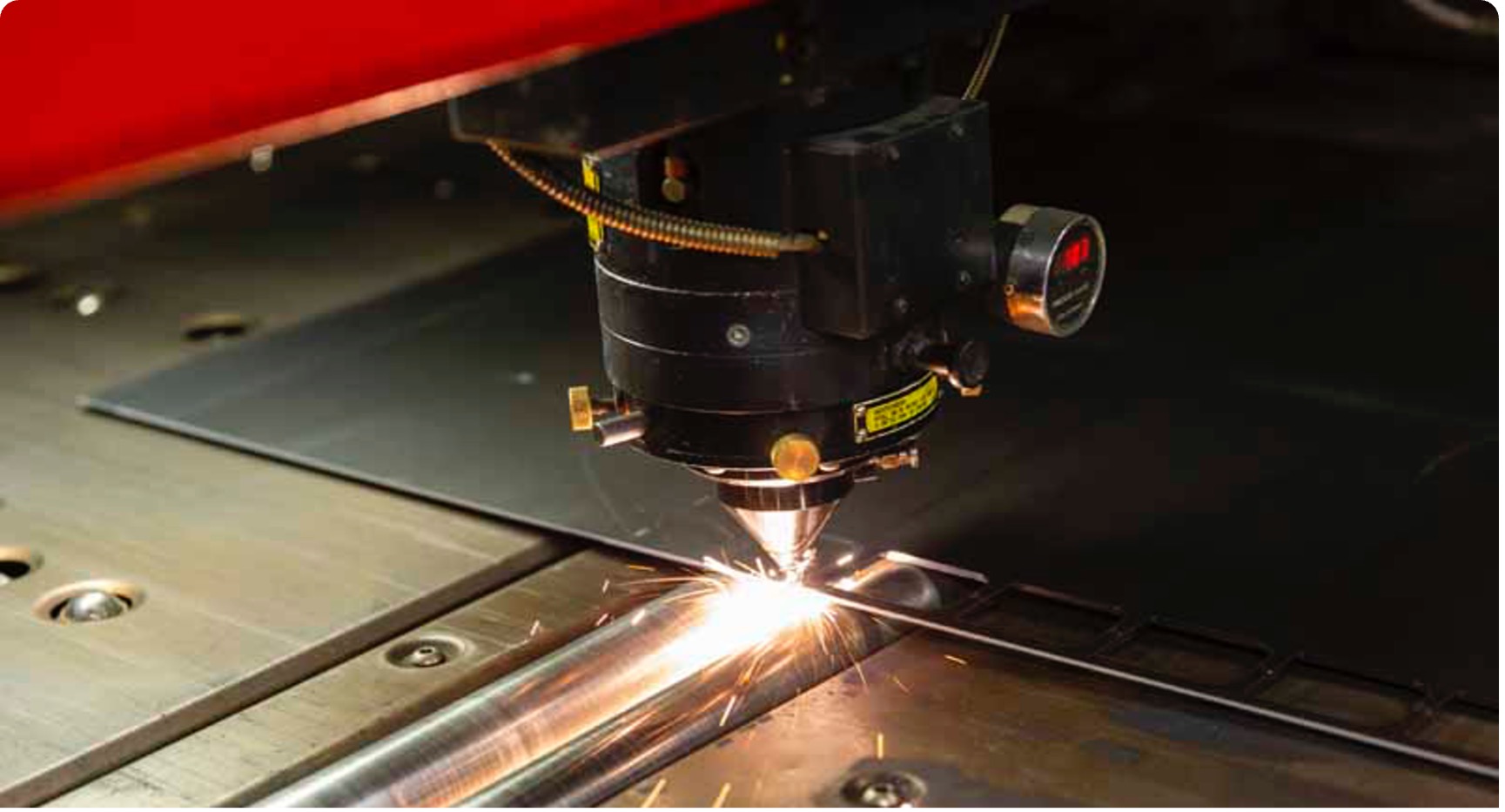
Fabrication is the first step in manufacturing where raw materials are cut, shaped, and assembled. It sets the structural groundwork for subsequent processes. However, fabrication is often plagued by dimensional deviations, manual inconsistencies, and time-consuming setups for high-mix part production.
These errors can cascade downstream, affecting weld alignment, surface quality, and increasing rework and costs. The reliance on skilled labor to interpret technical drawings further complicates production in HMHV contexts.
Welding: High Stakes, Shrinking Talent Pool
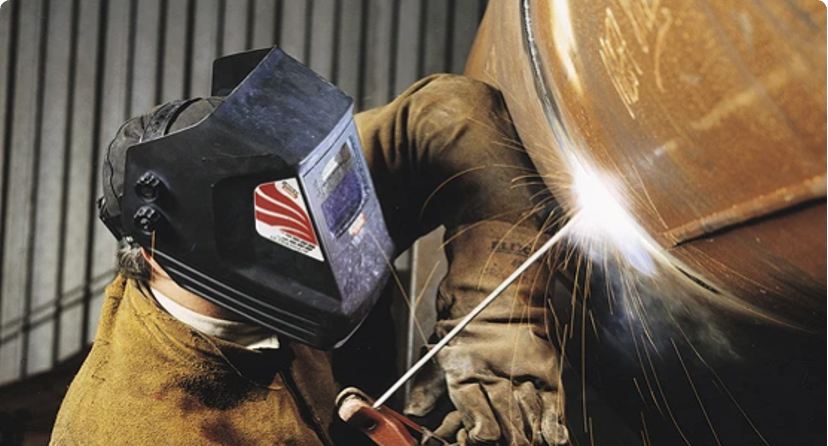
Welding is a fundamental industrial process that involves the joining of materials—primarily metals and thermoplastics—through the application of heat, pressure, or both, forming a permanent bond. With a market size of USD24.73 billion in 2023[5], welding is central to industries ranging from automotive and aerospace to construction and energy. Despite its ubiquity, it faces issues like weld defects, a shortage of skilled welders, and exposure to health risks.
Welding processes require dexterity and experience, making automation essential. However, current automation often falls short in HMHV environments due to rigid programming and limited adaptability.
Weld Grinding: Inconsistency by Design
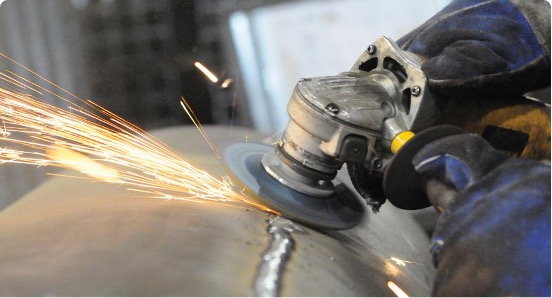
Weld grinding refines joints to meet mechanical and aesthetic standards. It is labor-intensive, tool-sensitive, and introduces variability based on operator skill. Dust and noise pose health hazards, and over-grinding can weaken structural integrity. Robotic systems are increasingly adopted, but only scalable if they can adapt across different parts and setups.
Sanding: Manual Work, Marginal Returns
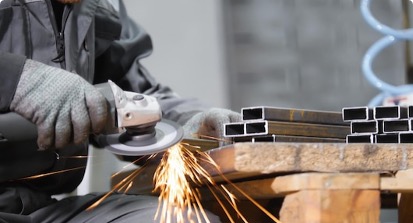
Sanding smooths and prepares surfaces for coatings or adhesives. While vital for functional and visual quality, it is often performed manually, leading to inconsistent results and over-sanding. It also presents significant health risks due to airborne particles that can be harmful when inhaled[6] and repetitive strain injuries where repetitive motion and awkward positioning can lead to operator fatigue or injury[7].
Blasting: Essential but Overlooked
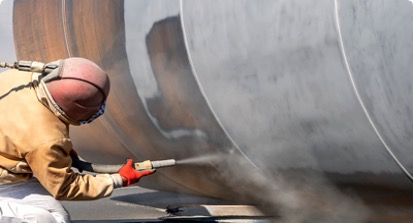
Blasting cleans and textures surfaces for further finishing. Blasting contributes significantly to product longevity, performance, and appearance in industries like aerospace[8] and shipbuilding[9]. Methods include abrasive, shot, glass bead, dry ice, and soda blasting. Manual blasting often yields uneven results and generates dust that complicates safety and environmental compliance.
Thermal Spray: Precision Required, Costly to Maintain
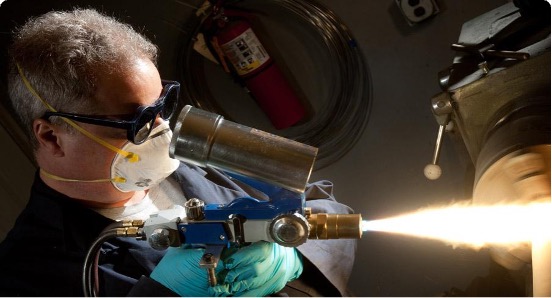
Thermal spray applies protective coatings for wear resistance and thermal insulation. Techniques such as flame spray, electric arc, plasma, HVOF, and cold spray are used depending on application needs. Challenges include controlling porosity, maintaining process precision, and justifying high equipment costs.
Painting: When Aesthetics Meet Engineering
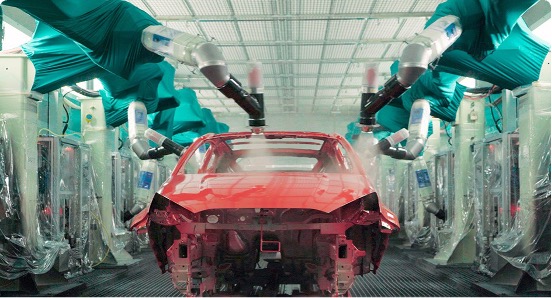
Painting enhances product appearance and durability. Variability in product types and surfaces requires reprogramming of paint toolpaths—a process that can take up to 28 hours. Health hazards from solvents, overspray, and inconsistent coverage underscore the need for safer and more efficient automated systems.
Final Application: Where Misalignments Surface

The final assembly and application of products expose all prior inefficiencies. Misalignment, environmental constraints, and insufficient quality control can lead to delays, rework, or product failure. Tight coordination of resources and skilled labor is required to meet performance and compliance standards.
Automation as a Unifying Solution
Substituting Labor
Skilled labor shortages affect nearly every stage of manufacturing. Tasks such as welding, grinding, and painting demand high dexterity and decision-making. Adaptive automation can substitute manual labor while maintaining process fidelity. For example, robotic welding has shown to reduce labor costs by 25–40%[10].
With advances in technologies like artificial intelligence and machine learning, the potential to automate complex and nuanced tasks such as welding and painting is now a reality. Instead of performing repetitive or hazardous work, skilled workers can be redeployed to oversee, optimize, and maintain these automated systems—further enhancing productivity and safety. Companies can leverage such technologies to address the shortfall of skilled labor while empowering their workforce to focus on higher-value responsibilities.
Reducing Reprogramming Barriers and Downtime
Traditional robotics require manual coding and CAD-based inputs, making them inefficient for HMHV production. In a world where HMHV products are becoming more prevalent, changing of parts and thus reprogramming toolpaths will become more frequent to adapt to these demands.[11] Adaptive systems equipped with automated path generation and self-optimization drastically reduce reprogramming time. This not only cuts costs (reprogramming can cost up to $50,000 per minute)[12][13] but also ensures agility in production.
Reducing Errors and Ensuring Consistency
Human error leads to defects and rework, impacting costs and timelines. Automation improves accuracy and repeatability. Studies show that automation can reduce defects by up to 90%[14], and automation inspections increase accuracy and consistency by 10% to 15% while improving efficiency by 30–50% and productivity by 25–40%[15].
Protecting Workers from Health Risks
Many steps in the manufacturing production line expose workers to health hazards.
- Welding: In Australia, 90% of welders are exposed to carcinogenic fumes,[16] and these fumes can also result in negative neurological and respiratory effects.[17]
- Sanding and blasting: Inhalation of harmful particles during sanding and blasting can result in respiratory diseases.[18] Moreover, some sanders operate hand-held power tools, which can cause Carpel Tunnel Syndrome.[19]
- Thermal spray: Exposure to toxic metal may result in respiratory diseases and even death.[20]
- Fabrication, weld grinding: Noise generated from these processes can result in hearing loss.[21]
- Painting: Exposure to painting chemicals can result in various diseases and increases risk of cancers.[22]
Automation removes operators from hazardous environments, significantly reducing occupational illnesses. Remote operation and enclosed robotic cells also lower noise levels and reduce accidents related to manual handling and repetitive strain injuries.
Enabling Data Analysis
Automated systems facilitate seamless data collection and analysis of data[23] across processes. This enables predictive maintenance, real-time monitoring[24], and process optimization. Manufacturers can make informed decisions faster and reduce unplanned downtime.
Looking Forward: A Strategic Imperative
The traditional production line, while foundational, is no longer fit-for-purpose in a world defined by complexity and customization. Forward-looking manufacturers that embrace adaptive automation will not only streamline operations but position themselves at the forefront of quality, safety, and scalability.
The path ahead is not just about technology adoption. It is about rethinking processes to make production line more intelligent, more resilient, and more adaptive to change.
Next Steps: See Adaptive Automation in Action
At Augmentus, we believe that future-ready manufacturing starts with automation that adapts—not just automates. Our no-code robotic programming and adaptive motion control technologies are designed specifically for high-mix, variable production environments. Whether you’re tackling part deviations in fabrication or struggling with reprogramming bottlenecks in painting, our system empowers engineers and operations teams to deploy automation with minimal disruptions.
Schedule a demo today to explore how Augmentus can help you reduce programming time by up to 90%, increase consistency across the production line and unlock measurable ROI—without the complexity.
References
[1] Yee, L. C. & Jim, C. (2011) Foxconn to rely more on robots; could use 1 million in 3 years. Reuters, August 21. Available at: http://www.reuters.com/article/2011/08/01/us-foxconnrobots-idUSTRE77016B20110801
[2] U.S. Bureau of Labor Statistics (2025) Manufacturing Sector: Unit Labor Costs for All Workers (ULCMFG). FRED, Federal Reserve Bank of St. Louis, 5 June. Available at: https://fred.stlouisfed.org/series/ULCMFG
[3] U.S. Bureau of Labor Statistics (2025) All Employees: Manufacturing (MANEMP). FRED, Federal Reserve Bank of St. Louis, 6 June. Available at: https://fred.stlouisfed.org/series/MANEMP
[4] World Economic Forum and Deloitte Touche Tohmatsu Limited (no date) The Future of Manufacturing: Opportunities to Drive Economic Growth. World Economic Forum in collaboration with Deloitte Touche Tohmatsu Limited. Available at: [URL] (Accessed: 9 June 2025)
[5] Fortune Business Insights (no date) Welding Market Size, Share | Global Research Report [2030]. Fortune Business Insights. Available at: https://www.fortunebusinessinsights.com/industry-reports/welding-market-101657 (Accessed: 9 June 2025)
[6] National Institute for Occupational Safety and Health (NIOSH), 1987. Health effects of exposure to wood dust: a summary of the literature. [pdf] Morgantown, WV: U.S. Department of Health and Human Services, Public Health Service, Centers for Disease Control, National Institute for Occupational Safety and Health, Division of Standards Development and Technology Transfer. Available at: https://www.cdc.gov/niosh/docs/wooddust/pdfs/exposures-references.pdf [Accessed 28 May 2025].
[7] Mercury Legal Online, n.d. Does your job cause repetitive strain injury? [online] Available at: https://www.repetitive-straininjury.co.uk/jobs/ [Accessed 28 May 2025].
[8] Blue Line Abrasives, 2023. Maximising efficiency in aerospace maintenance with abrasives. [online] Available at: https://bluelineabrasives.co.uk/blog/maximising-efficiency-in-aerospace-maintenance-with-abrasives/ [Accessed 2 June 2025]
[9] Sandblasting Liverpool, 2023. The role of sandblasting in the marine industry. [online] Available at: https://www.sandblastingliverpool.com/the-role-of-sandblasting-in-the-marine-industry [Accessed 2 June 2025]
[10] Deloitte and Blue Prism (2020) Calculating the real ROI on Intelligent Automation [White paper] Available at: https://www2.deloitte.com/content/dam/Deloitte/us/Documents/technology-media-telecommunications/blue-prism-white-paper-final.pdf (Accessed: 9 June 2025).
[11] Boston Consulting Group (2022) How to Close the Automation Revolution Gap in Manufacturing. Boston Consulting Group. Available at: https://www.bcg.com/publications/2022/closing-automation-revolution-gap-in-manufacturing (Accessed: 10 June 2025)
[12] igus® Engineer’s Toolbox (no date) Stop Spending Millions on Robot Downtime Now. igus® Engineer’s Toolbox. Available at: https://toolbox.igus.com/3773/stop-spending-millions-on-robot-downtime-now (Accessed: 10 June 2025)
[13] PrimeTest (2021) Reduce Changeover Time in Your Manufacturing Environment Through Flexible Factory Automation. PrimeTest. Available at: https://www.primetest.com/post/reduce-changeover-time-in-your-manufacturing-environment-through-flexible-factory-automation (Accessed: 10 June 2025)
[14] International Federation of Robotics, “World Robotics Report,” 2021
[15] Michael Lynch (no date) Unleashing the Power of Automation: Automated Quality Inspections in Manufacturing. Available at: https://praxie.com/automated-quality-inspections-in-manufacturing (Accessed: 10 June 2025)
[16] Michelle Wisbey (2024) ‘Concerning’: Study finds 90% of welders exposed to carcinogens. Available at: https://www1.racgp.org.au/newsgp/clinical/concerning-46-000-welders-exposed-to-carcinogens (Accessed: 10 June 2025).
[17] Centers for Disease Control and Prevention (CDC) (2024) Welding Fumes and Manganese. Available at: https://www.cdc.gov/niosh/welding/about/index.html (Accessed: 10 June 2025).
[18] Health and Safety Executive for Northern Ireland (HSENI) (no date) Occupational lung disease. Available at: https://www.hseni.gov.uk/topics/occupational-lung-disease#:~:text=for%20many%20years.-,Silicosis,rock%2C%20concrete%2C%20and%20mortar. (Accessed: 10 June 2025).
[19] Health and Safety Executive (HSE) (no date) Reportable occupational diseases. Available at: https://www.hse.gov.uk/riddor/occupational-diseases.htm (Accessed: 10 June 2025).
[20] Antonini JM, McKinney WG, Lee EG, Afshari AA. Review of the physicochemical properties and associated health effects of aerosols generated during thermal spray coating processes. Toxicol Ind Health. 2021 Jan;37(1):47-58. doi: 10.1177/0748233720977975. Epub 2020 Dec 11. PMID: 33305691; PMCID: PMC7988297.
[21] Occupational Safety and Health Administration (OSHA) (no date) Health Effects of Noise Exposure. Available at: https://www.osha.gov/noise/health-effects. (Accessed: 10 June 2025).
[22] National Center for Biotechnology Information (NCBI) (no date) [Title of the Book or Report]. Available at: https://www.ncbi.nlm.nih.gov/books/NBK304433/ (Accessed: 10 June 2025).
[23] Tilley, J. (2017) Automation, robotics, and the factory of the future. McKinsey & Company. Available at: https://www.mckinsey.com/capabilities/operations/our-insights/automation-robotics-and-the-factory-of-the-future (Accessed: 10 June 2025).
[24] PwC (2018) Industry 4.0: Building the digital enterprise. Available at: https://www.pwc.com/gx/en/industries/industries-4.0/landing-page/industry-4.0-building-your-digital-enterprise-april-2016.pdf (Accessed: 10 June 2025).


